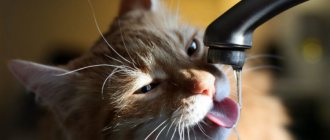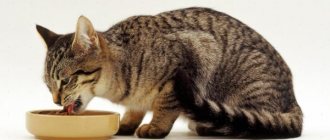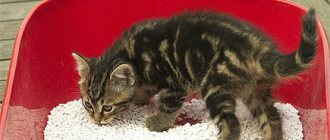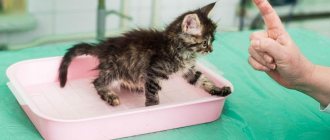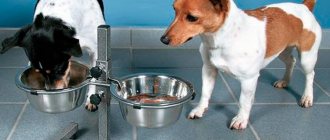Before getting a pet, many owners find out how long a kitten should normally go to the toilet for major and minor needs. It is important to take into account that the number of urinations and bowel movements in young and adult individuals is different. If the pet often sits in the tray for a long time, then the owners should be wary, because if the cat often goes to the toilet, this may indicate problems with the gastrointestinal tract and disorders of other internal organs and systems.
What affects going to the toilet?
Before you start getting acquainted with the “norms,” it’s worth talking a little about what affects the number and frequency of visits to the litter box.
Firstly, this is, of course, age. Kittens, adults and older cats go to the toilet with different frequencies. Secondly, the regime and diet. Everything is simple here, for example, the more often your pet drinks, the more often he will visit the litter box. In addition, each cat, like a person, has its own habits and rhythm of life, so it is not surprising that one pet has to be cleaned 2-3 times a day, while another can be found in the tray only once a day. That is, it is necessary to make allowances for the characteristics of a particular animal and its body.
When do kittens start pooping?
The health of animals in childhood and adulthood directly depends on how well babies have defecation and urination.
Inexperienced owners may think that their pet does not go to the toilet until almost a month old, because they do not find traces of vital activity on the litter. However, like any living organism, the kitten empties its intestines and bladder.
This happens from the very moment of birth, but the cat helps babies go to the toilet by massaging the cubs’ stomach and anal area with their tongue, stimulating defecation. After the cub has done its business, the mother licks the urine and stool, which has a consistency similar to a thick paste.
How many times do kittens go to the toilet?
Very young kittens (up to 3-4 weeks) feed exclusively on mother's milk. Their digestive system is not yet very developed, so there is no need to talk about any regularity.
Starting from the age of one month, kittens learn to drink milk from a saucer and gradually become interested in other foods, including solids. In addition, at this age their digestion is improving, so, although irregularly, they need to go to the toilet. On average, up to three months, a kitten can go to the toilet from 1 to 3 times a day, both “big” and “small”
Starting from 3 months of age, the process of going to the toilet should gradually normalize and become regular. The acceptable maximum can be considered 3 “piles” and 6 “puddles”. The high activity of the kitten has a big influence here, because at this age he constantly plays and runs around a lot, which is why he drinks a lot.
How many times
If we talk about average urine values, it varies from 50 to 300 ml. But in practice, the number of times a cat goes to pee varies greatly depending on many different factors. Let's note some of them:
- Individual characteristics of the body. Essentially the main factor that determines how many times a cat goes to the toilet. Physiological and psychological characteristics greatly influence the animal’s urination. For example, a lazy and apathetic cat can go to the toilet 1, maximum 2 times a day.
- Diet. If dry food predominates in a cat's diet, he may drink more water, thereby urinating more often. Therefore, it is extremely important to choose the best products for your pet.
- Weight and dimensions of the cat
- Breed
- Age. The older the animal gets, the less often it can go to the toilet due to its advanced age.
- The fact of pet sterilization
- Gender of the animal. Oddly enough, a lot depends on the gender of the animal - a stern cat or a graceful cat.
- Lifestyle (passive or active).
Let's dwell on some points in more detail and start with gender differences. A cat pees about 1-2 times a day, and a male can increase the frequency up to 6 times (for castrated individuals).
Why did nature arrange it this way? It all depends on the physiological characteristics of the sexes, namely:
- the urinary ducts of cats are thinner than those of females;
- the shape of the channels is curved, so in order to completely get rid of urine, cats have to go to the toilet more often;
- castration greatly affects the size of the canals, narrowing them, which forces an increase in the number of urinations.
Ultimately, the average values for trips to the toilet in cats are determined to be 3-4 times a day, in castrated animals up to 10 (!). Cats behave more restrained, pee little, about 1-2 times a day.
ATTENTION! Due to their physiological characteristics, cats are more often susceptible to urolithiasis. This is due to the curved shape of the channels, where salt crystals are more likely to settle.
Many owners worry that their cat goes to the toilet more often during estrus or pregnancy. Experts say that this is completely normal in this situation. It is worth noting that the animal’s temperament greatly influences the number of trips to the toilet. For example, if a cat is active, constantly explores an apartment or house, and cannot live a day without playing with family members, then he will urinate more often.
Active recreation requires a lot of resources from the body, given that a large amount of water evaporates with sweat. The animal is forced to replenish energy losses and equalize the water balance. All this inevitably leads to another trip to the tray. No need to worry in this case.
The owner must always make allowances for physiological and psychological characteristics, not excluding lifestyle. For one cat, two times will be enough, but for another, six times will not be enough.
Adults
A cat can be considered relatively mature from the age of 6 months. By this point, internal processes in their bodies usually normalize, and pets also develop their own habits. However, trips to the toilet can still be quite frequent - up to 3 and 5 times, respectively.
The cycle is finally established after a year. It is then that you can clearly trace the number and frequency of visits to the tray, and also notice that they often coincide in time.
Adult cats with a moderate diet go to the toilet “largely” 1-2 times a day.
As for the functioning of the urinary system, everything is somewhat more complicated: it is structured differently in males and females. So, the urinary ducts of cats are much thinner and more tortuous, so they are unable to completely empty their bladder, which, in turn, leads to more frequent sitting in the litter box - up to 4 times a day. Neutered cats go to the toilet even more often, and even 6 trips in 24 hours is considered the norm in their case.
Cats usually go to the litter box 1-2 times a day, but during pregnancy these numbers may be slightly higher.
In rare cases, castrated cats and sterilized cats, characterized by low mobility and laziness, can go to the toilet even once a day without experiencing any problems.
As for quantitative indicators, in a healthy adult animal, on average, the amount of excrement per day can reach 100 grams, and urine - up to 500 milliliters.
Deviations from the norm
In order to detect the disease in time, the owner needs to know how many times the cat should go to the toilet. Occasionally, cases arise when a pet visits the litter box once every two days. This phenomenon is not considered dangerous, because it is associated with certain changes in the life of the animal:
- Climate change.
- New food.
- Conducted castration or sterilization. It takes up to three days to restore genitourinary function in cats. Cats take much longer to recover because their surgery is more in-depth.
- Stress.
Pathological abnormalities include various inflammatory processes. They can be identified by the following symptoms:
- no urination for more than two days;
- the animal often meows while going to the toilet, thereby showing that it is in pain;
- the presence of mucus, sand, blood in the urine;
- difficulty urinating with small discharge;
- increased body temperature;
- lack of appetite;
- apathy or irritability;
- swelling in the abdominal area;
- dry and hot nose, pale gums, hot and dry tips of the ears.
Dog pregnancy calendar by week and day for caring owners
For the sake of their pets' health, owners should pay attention to how many times cats go to the toilet. The most common disease in animals is urolithiasis. The cause of its occurrence may be hypothermia, eating cheap food, or poor hygiene. Cats are most often affected by this disease due to the specific structure of their organs. If your animal develops any of the above symptoms, you should immediately contact your veterinarian.
When should you contact a veterinarian?
Pathology is indicated by weakness, lethargy and apathy, excessive appetite or refusal to eat, and weight loss. Other reasons to contact a veterinarian:
- indigestion (vomiting, diarrhea or constipation);
- increased or decreased body temperature;
- pallor of the mucous membranes;
- uncharacteristic impurities in the urine (pus, blood);
- strong unpleasant odor of urine.
Some diseases have subtle symptoms, so if the deviation in the number of urination acts persists for more than 3 days, you should show your pet to a doctor. Under no circumstances should you self-medicate; this can aggravate the situation and lead to dangerous complications.
Frequency of trips to the litter box in adults and small animals
The frequency of urination depends on the anatomical structure of the animal. Question “How many times a day should a 1 month old kitten pee?” is logical, since in the first six months of life the internal structure of the cat’s body changes rapidly. Newborn kittens usually go to the toilet once a day, but over time the amount of urination increases.
There is also no clear answer to the question of how many times a day a 1.5 month old kitten should pee. But as you get older, trips to the toilet become more frequent. The small representative of the cat family reaches its peak of activity at the age of 5-6 months. An animal that has reached the age of six months can run into the tray up to 10 times.
How many times a day should a 3 month old kitten pee? Veterinarians do not give exact numbers, but it is understood that the frequency of urination at this age depends on the activity and lifestyle of the pet. This rule also applies to adults. Normally, an adult animal can go to the toilet from 2 to 6 times a day.
Many veterinarians, answering the question of how many times a day a cat should pee, recall the differences in the urinary system in females and males. Cats pee twice as often as adult cats because their urethra are narrower and can hold less urine. After castration, the size of the canals narrows even more. Therefore, veterinarians, answering the question “How many times a day should a neutered cat pee,” voice the figures from 2 to 6 times.
Reasons for deviations from the norm
The nutrition of a domestic animal is of great importance. Many owners change their pet’s diet and ask the question, “How many times a day should a cat on dry food pee?” Due to the abundant consumption of dry food, the animal needs more water, the use of which causes a frequent urge to urinate.
How many times a day should a cat on wet food pee? Wet food requires less water and the animal is less likely to feel thirsty, so these pets do not tend to visit the litter box more often. Nutritional characteristics play an important role in determining the normal frequency of pets going to the toilet.
Deviations from the norm can easily be confused with a situation where age-related regulation of urination patterns occurs. Some owners cannot understand how many times a day a 2-month-old kitten should pee. At this age, the cat’s body adapts to the external environment, so the animal’s rare trips to the toilet are perceived as deviations from the norm.
Dangerous delays of 2-3 days can be caused by the following reasons:
- severe stress (change of owners, disruption of usual place of residence);
- sudden change in diet;
- castration and sterilization.
Such changes lead to malfunctions in the functioning of the urinary system. Representatives of the cat family quickly adapt to changes, so it takes 3-4 days to restore the regime in adults.
Symptoms and prevention of urolithiasis
Having decided how many times a day a 4-month-old kitten should pee, pet owners often ignore real symptoms that indicate problems with the urinary system. Irregular urination may indicate urolithiasis, which is more common in males of any age.
The occurrence of diseases of the kidneys and genitourinary system is accompanied by the following symptoms:
- complete absence of urine for 2 days;
- difficulty or painful urination;
- the content of blood impurities and sand in the urinary fluid;
- loss of appetite;
- temperature increase;
- lethargy and apathy.
To summarize how many times a cat pees a day, you can indicate the average figure - 3-5 times a day. Little kittens up to six months visit the litter box 1-3 times a day; after 6 months, the number of trips increases sharply - up to 6 times. Adult cats go to the toilet 2-3 times a day.
After clarifying the question of how many times a day a cat urinates, it is worth checking these indicators with real ones. In case of a discrepancy, the pet animal is treated for the corresponding disease. The best prevention of urolithiasis is considered to be general strengthening and antibacterial measures, dietary therapy and regular care of the animal.
What causes urinary problems?
Changes in urination norms can be both harmless and directly indicating the development of diseases.
Non-hazardous reasons:
- stress caused by global changes in life (change of climate, place of residence, owners, “moving” other animals into the apartment, fear, etc.);
- sudden transition to another diet;
- castration, sterilization.
These reasons lead to pets becoming depressed and having a hard time with sudden changes in their lives, which leads to malfunctions of organs, including the urinary system. Typically, restoration of functions occurs in males within 3 days, in females – a little longer, but everything goes away without medical help. Cats are quickly adaptable animals, so getting used to new things does not take much time and does not have time to seriously harm their health. And if pets normally have to pee 2-3 times a day, then this will soon happen, despite the stress they have suffered.
Serious reasons:
- the animal has not peed for 2 days (or vice versa - it urinates too often and little by little);
- writing is obviously difficult and painful (the pet moans, meows);
- there are impurities in the urine that indicate diseases;
- the pet’s mood is apathetic, lethargic;
- the animal does not eat well;
- there are signs of malaise (fever, pale gums, dry nose, hot tips of the ears, etc.);
- The pet's belly is swollen, tight, and there is pain on palpation.
If any of these signs are present, the animal urgently needs to be taken to the veterinarian. Changing your diet and changing the amount of drink will no longer help here, and self-medication for diseases that manifest themselves in the form of such symptoms is unacceptable.
Summarizing how much a cat usually normally pees in a day, we can say that it is individual and depends on a number of factors. But on average, small kittens pee from 1 to 3 times, from six months - up to 5-6 times, an adult healthy animal - 1-2 times (cats) and 3-5 times (males). If at the same time the pet clearly feels great in all respects, then everything is definitely fine with him.


